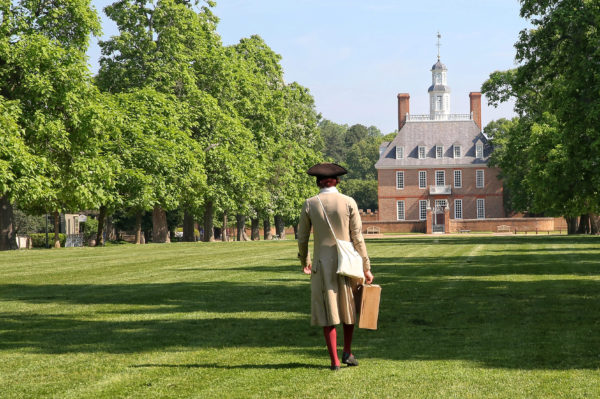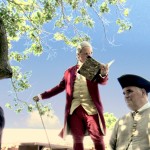
Meet Zachariah Hill, an itinerant artist who has come to Williamsburg and made his services available for “shades,” that is, miniature profiles rendered in ink and watercolor. We’re not sure how long he will be in town, but he has shared several excellent examples of his work, and many esteemed residents have already scheduled appointments.
Zachariah is the alter ego of Zach Hillegas, and this week he begins testing the waters plying the Historic Trade of itinerant artist. Unlike many of the shops that could sustain their business in one location, the artist’s trade often required a willingness to range wherever they could find the demand for their work. Such wanderers typically announced their arrival with advertisements in a local newspaper.
Williamsburg would have been a likely location as the colonial capital, particularly when the court was in session and the town’s population swelled dramatically. An artist, especially a young one seeking to establish a reputation, had to go where the people were. Especially the sort of influential people whose patronage could launch a career.
Artists also served frequently as apprentices early in their careers. Many learned the work mixing the paints for their master, which was no mean feat 200 years ago. Since there was no effective way to store paint, you would mix just enough for a day.
Zach has adopted a backstory that takes as much as it can from his own experience. He hails from Pittsburgh, for example, but since that was a remote outpost in the 1700s, Zachariah Hill is said to be from Philadelphia.
Zach has had a passion for art since he was old enough to hold a pen or brush, and he attended a school for the arts, where he received a broad education in different media: not only watercolor, acrylics, and oils, but also printmaking, sculpture, figure drawing, ceramics, digital media, and more.
This rich experience informs the alter ego. Speaking as Master Hill, he says, “I always had a knack for art, so I studied as much as I could without a master to the point where I thought my skills were good enough to pursue it as a career.”
“Shades,” or shadow portraits, are what are commonly known today as silhouettes. (The term “silhouette” emerged years later, originating as a swipe at an unpopular French finance minister by that name who happened to make shades as a hobby. The name stuck.)
Shades first became a popular art form in France in the late 1500s. The earliest-known English examples were likenesses of the regents, William and Mary, cut by Elizabeth Pyburg in 1699. The height of their popularity ranged from the 1770s to the 1860s.
The popularity of shadow portraits grew quickly in Europe, and spread to America, after the publication of Johann Lavater’s 1778 Essay on Physiognomy, which asserted that physical characteristics apparent in a profile could reliably be connected to one’s character. Lavater’s groundless theories foreshadowed similar pseudo-scientific notions that became quite popular through the 19th century.
Lavater’s book helped to spur a growing interest in shadow portraiture in elite circles. Many examples from the late 1700s feature George Washington, though it’s not clear how many of them he actually sat for. The example above was cut in 1791. It’s not the most flattering profile of the Father of Our Country.
Major Andre, the British officer who was hanged for spying in 1780, actually made a number of shades in the 1770s. His subjects included Gen. Burgoyne, George Washington, and Benjamin Franklin.
Zach explains that shades were an ideal type of work for an itinerant artist to do because they were “quick and stylish,” requiring a much shorter sitting than more elaborate oil paintings.” They were also affordable, with some ads from the period pricing them at two to six shillings.
Most shades were actually profiles cut freehand. There were several techniques used to accomplish this. The example above from Colonial Williamsburg’s collections is a hollow-cut portrait of Miss Fessenden made by William King, a traveling artist from Salem, Massachusetts. It’s believed to have been created in the first decade of the 19th century. A contemporary noted that he “dragged his family from town to town,” and that he was “a wanderer, an ingenious mechanic, but full of projects, & what he gains from one, he loses in another.” King used mechanical aids to create his shadow portraits and sometimes folded the paper he was cutting to produce two images at once.
Zach practices the more refined style of painted shadow portraiture. But even painted shades were relatively inexpensive because they only used a single color. He uses ink and watercolor, although in the 18th century almost anything could be used, even lampblack or charcoal.
The affordability made shadow portraits appealing to the middling sort in society, and to those with aspirations of climbing a bit higher on the social ladder. The popularity of the form led to the gentry favoring it as well, but a well-heeled client might add flourishes that would serve as expressions of wealth. They might have a portrait bronzed, with gold painted right onto it. They might use a more expensive surface, such as black silk or ivory, or even on the household flatware.
On most days, our itinerant artist will work out of the side room of Mr. Greenhow’s store. On Fridays, and on Saturdays until 2 p.m., you’ll find him outside at the Market House.
The sitting usually takes 40 minutes or so. Zach captures the outline of the face in perhaps ten minutes, then spends the rest of the time filling in the color and detail. He uses ink and watercolors. The paper is from the print shop.
When you sit with Master Hill, you’ll have the opportunity to chat about the artist’s life and his process. It’s part of the experience. He works out the details of the portrait through conversation. For Zach, portraiture isn’t meant to be photographic. For him, the magic of portraiture lies in the attempt to capture the essence of a person—their personality, how they relate to the world—more than a rote likeness.
18th-century portraits, says Zach, were “a biography in visual form.” In oil portraits, this was accomplished by the setting the subject was placed into, the objects and people that surrounded them. In a shadow portrait the effect is more subtle. Is there a hat? Is this a member of the gentry class or a tradesperson? What other details might reveal something of one’s personality.
It’s an hour well spent. However, a portrait does takes some time to completely dry, so it’s best to return to Greenhow Store at the end of the day to pick it up.
Would you like to have your portrait drawn?
Please pay a visit John Greenhow’s Store on Duke of Gloucester St. and inquire about having a likeness made. Mr. Greenhow’s assistants will fetch the reservation book, and you are free to make an appointment up to a week in advance.
Sittings are on the hour, Thursday through Monday, from 10 a.m. to 5 p.m. excluding the 2 p.m. dinner hour. The cost is $45 for a shade of approximately five-by-seven inches.
If you frequent the auctions, you might also be able to purchase a larger eight-by-ten inch likeness. The larger size is offered exclusively through the auction.
Special thanks to Fred Blystone and Mairin Hayes for the pictures for this post!

I had one done while I was in Colonial Williamsburg during the last week of June, 2016. In fact, my sitting was on June 30th while I was wearing my own period clothing, and Zach really did an amazing work of period art. The best part is my children could tell it was definitely me.
It now hangs proudly in our family room.Money well spent.
Zach’s “shades” are fabulous! I think that appointment book will fill up fast.
His work is absolutely stunning. I’ve seen it first hand and the detail Zach puts into each of his drawings is mind boggling. His definitely knows his craft. Not only is Zach a great friend, but he is also a wonderful asset to Colonial Williamsburg. I’m so happy he’s able to showcase his talent to everyone.
I like that, as an artist, Master Hill has splashed out hos shillings on a bright blue weskit and red hose. I could imagine him prchasing a few coloured ribbands to make a cockade fr his tricorne.